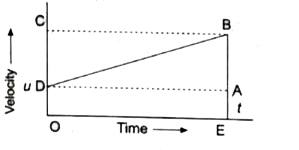In a free fall the velocity of a stone is increasing equally ion equal intervals of time under the effect of gravitational force of the earth. Then what can you say about the motion of this stone? Whether the stone is having:Solution in Tamil
-uniform acceleration
Non-uniform acceleration
retardation
constant speed
The correct Answer is:a
An object is in motion with initial velocity u attains a final velocity v in time t due to acceleration a, with displacement s.
Let us try to derive these equations by graphical method. Equations of motion from velocity-time graph:

Graph shows the change in velocity with time for an uniformly accelerated object. The object starts from the point D in the graph with velocity u. Its velocity keeps increasing and after time t it reaches the point B on the graph .
The initial velocity of the object =u = OD = EA
The final velocity of the object =v=OC = EB
Time = t= OE = DA
Also from the graph we know that , AB=DC
For first equation of motion
By definition, acceleration =change in velocity / time
=(final velcity -initial velocity ) / time
=(OC-OD)/OE=DC/OE
a=DC/t
DC=AB=at
From the graph EB=EA+AB
v=u+at ....(1)
This is first equation of motion.
For second equation of motion
From the graph the distance covered by the object during time t is given by the area of quadrangle DOEB
s=area of the quad-rectangel DOEB
s=area of the rectangle DOEA + area of the triangle DAB
=(AE x OE) + (1/2 x AB x DA)
s=ut+1/2at2. ...(2)
This is second equation of motion.
For Third equation of motion
From the graph the distance covered by the object during time t is given by the area of the quadrangle DOEB . Here DOEB is a trapezium . Then
s=area of trapezium DOEB
=1/2 x sum of length of parallel side x distance between parallel sides
=1/2 x (OD +BE) x OE
s=1/2 x (u+v) x t
since a =(v-u)/t or t=(v-u)/a
Therefore s=1/2 x (v+u) x (v-u)/a
2as=v2−u2
v2=u2+2as ....(3)
This is third equation of motion.
Topper's Solved these Questions
Similar Questions
The numerical ratio of displacement to distance for a moving object is:
View SolutionA stone is falling freely. The distance travelled in the last second is equal to that travelled in the first three seconds. The time spent by the stone in air is
View Solutionएक पत्थर स्थिर अवस्था से स्वतंत्र रूप से गिर रहा है। इसके द्वारा गति के अंतिम सेकण्ड में चली गयी दुरी, गति के पहले तीन सेकण्ड में चली गयी गई दुरी के बराबर है। पत्थर वायु में रहा
View SolutionAccording to Newton.s third law of motion, if the earth pulls a stone, the stone must also pull the earth. Then why doesn.t the earth fall towards the stone ?
View SolutionWhich force acts on the stone in free fall after you release it?
View SolutionTake a small stone. Hold it in your hand. What are the forces acting on the stone ? Now release the stone. What do you observe ? What are the forces acting on the stone after you release it ?
View SolutionA stone is dropped from a height equal to nR , where R is the radius of the earth, from the surface of the earth. The velocity of the stone on reaching the surface of the earth is
View SolutionA stone falls freely from rest and the total distance covered by it in the last second of its motion equals to the distance covered by it in the first three seconds of its motion. What much time for the stone remains in air?
View Solution
